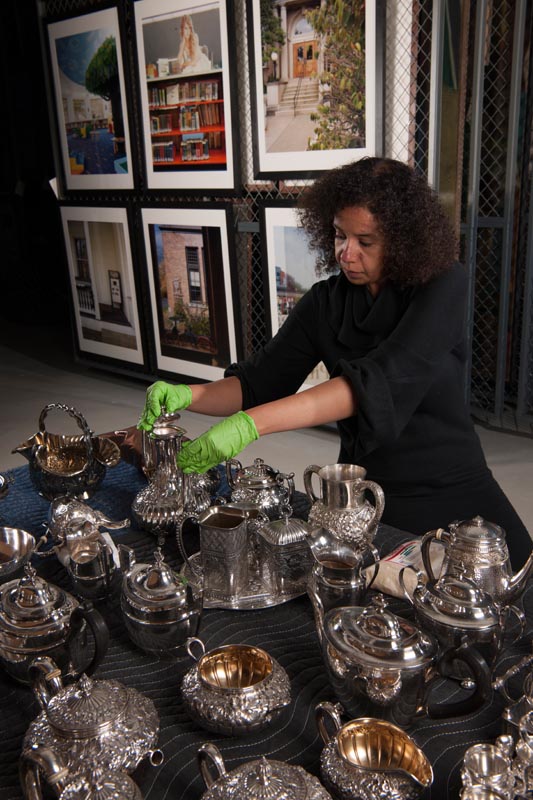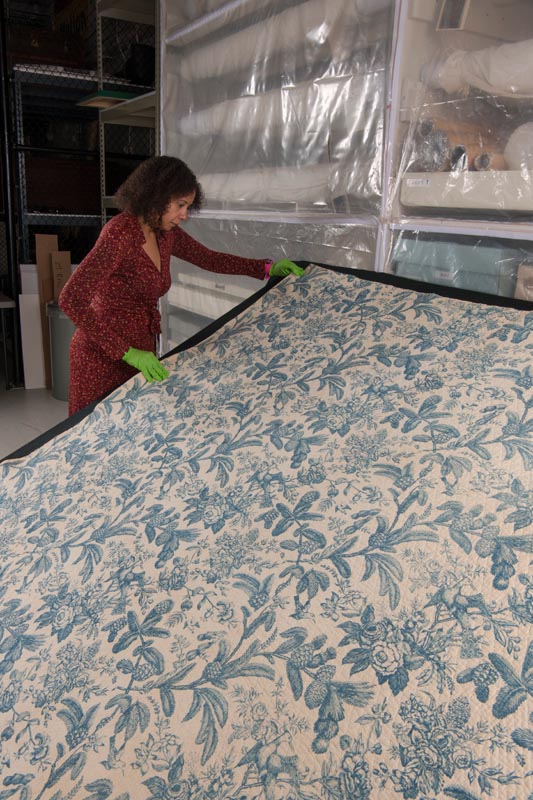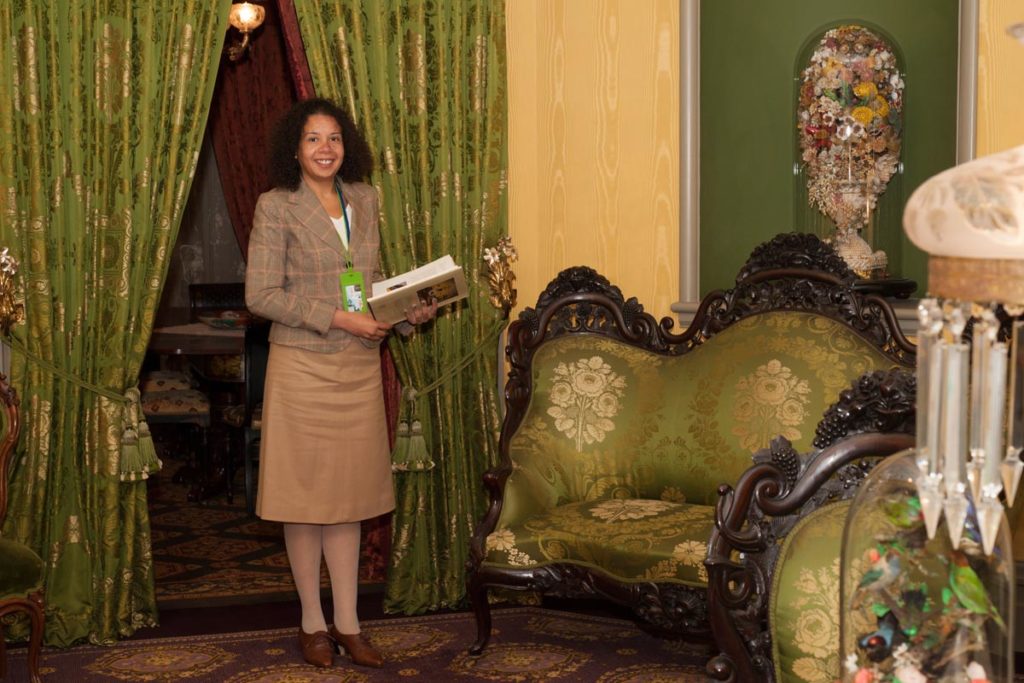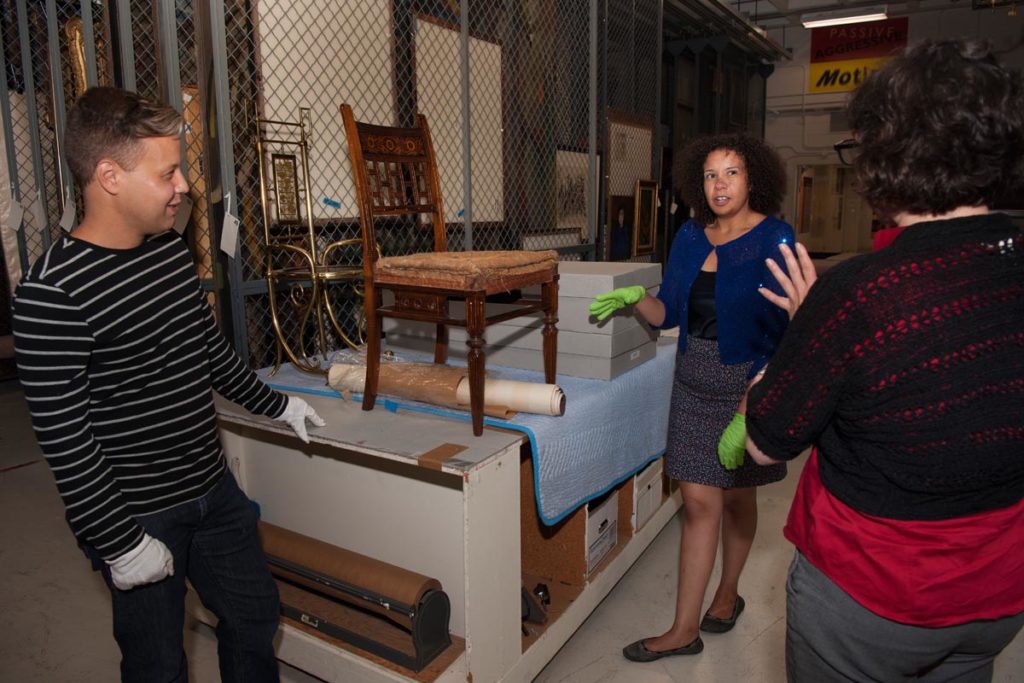Trust Curatorial Intern Playing Important Role at MWPAI
EMERGING SCHOLARS > CURATORIAL INTERNSHIP GRANTS
By MAUREEN MARTON,
The Decorative Arts Trust Curatorial Intern, Munson-Williams-Proctor Arts Institute Museum of Art
I arrived last December in Utica to embark on my museum career as the Decorative Arts Trust Curatorial Intern at the Munson-Williams-Proctor Arts Institute Museum of Art (MWPAI), a position created through a generous grant from the Trust’s Emerging Scholars Program. My academic studies focused on 20th-century American textiles and costume while attending the Smithsonian-George Mason History of Decorative Arts Graduate Program. During the first year of my internship I have already gained tremendous hands-on knowledge working with a broad assortment of American and European decorative arts and assisting with exhibition planning and development. An essential component of this experience is the mentorship of an experienced and talented supervisor, and I am fortunate to be working with Museum Director Anna D’Ambrosio, who is a highly regarded scholar.
The key to “unlocking” my first assignment at MWPAI was researching a collection of recently donated Aesthetic-style brass doorknobs and hardware. I searched through hardware company catalogues, antique doorknob databases, and U.S. patent records and assigned makers, dates, and models to about eighty-five percent of the doorknobs. I recorded my findings in MWPAI’s collection database, The Museum System (TMS), which was my first time using the world’s leading collection management software. Thanks to this experience, I am now very comfortable utilizing TMS to handle every facet of museum collections organization, from object records and exhibitions files to insurance policies and shipping activities.
The doorknob project proved excellent background for my work on updating object records for the MWPAI website. By the spring of 2017, online collections access will be enhanced with the addition of e-Museum, TMS’ web portal. Thanks to a major grant from The Institute of Museum and Library Services Core Collections Digitization & Dissemination Project, nearly 5,000 objects in the permanent collection will be accessible as a public educational resource, including 2,000 records that will benefit from new, high-quality digital images.
My exhibition responsibilities began with a loan exhibition from the New York State Museum in Albany. Seneca Ray Stoddard: Capturing the Adirondacks explored the career and impact of this 19th-century photographer, lecturer, and environmentalist. I oversaw all aspects of the exhibition and served as the public face of the show, liaising with other departments, meeting with private collectors to secure additional loans, and writing promotional materials, such as an article for the MWPAI’s monthly Bulletin. I was also interviewed by the local newspaper and television station!
I will build on this experience by developing two exhibitions in 2017. The first is dedicated to some of the most spectacular clothing of the Williams and Proctor families, the founders of the Arts Institute and Museum. In the late 1950s, the MWPAI decided not to develop a fashion collection and donated its historic clothing to the Farmer’s Museum in Cooperstown, NY. Nearly 60 years later, MWPAI will organize the first-ever show of the Williams-Proctor clothing collection. I am fortunate to embark on this project as my graduate training focused on late-19th- and 20th-century costume and textiles and am honored to have a chance to educate the public about how such clothes were constructed, how they functioned in 19th-century New York high society, and the stories they reveal about the people who wore them.
My second exhibit, George Washington: Did Not Sleep Here!, will highlight artwork in the MWPAI’s permanent collection that commemorates our first president. Objects that depict Washington’s image—including paintings, ceramics, glass, engravings, prints, textiles and medals— will testify to his perseverance in American material culture and myth.
In addition to the aforementioned projects, I have contributed to others around the museum. For the summer 2017 featured exhibition Roaring into the Future: New York 1925–1935, I have researched works and visited other museum collections in central New York in search of potential loans. This show will highlight decorative and fine art objects created in New York. Roaring into the Future explores the pivotal role the state’s artist and designers played in creating a thoroughly modern national style, as it evolved from Eurocentric origins to a uniquely American interpretation of art and consumer goods for the 20th century. I am also writing labels on objects selected for Art in Pieces: Crazy Quilts, which opens in February. Last fall, I contributed to the museum’s annual Victorian Yuletide exhibition, overseeing the installation of the parlor period setting. The room depicts a cheerful champagne and dessert party in keeping with this year’s festive foods theme, A Taste of the Holidays.
My internship has provided the opportunity to visit the homes of private collectors and lenders to the museum, behind-the-scenes access at other New York State museums’ storage facilities, and contact with well-established curators and historians in the decorative arts field throughout the area. I have also researched museum purchases from auction houses, such as a Staffordshire creamware transfer-printed jug, which will debut in the upcoming George Washington exhibition.
Conservation duties are also on my curatorial plate. I participated in a workshop on caring for silver in museum collections conducted by the Williamstown Art Conservation Center, in Williamstown, MA. I was subsequently tasked with cleaning silver and silver-plate objects in preparation for new photography to be uploaded to the e-Museum online collections site. Additionally, I will attend a historic house museum housecleaning workshop in March.
The Decorative Arts Trust Curatorial Internship is an indispensable first step in my museum career. My first year at MWPAI was both educational and enriching, and I look forward to seeing our 2017 exhibitions come to fruition. I am grateful for the support of the Decorative Arts Trust’s membership. Their gracious contributions make such opportunities possible for young professionals seeking a foothold in the decorative arts field. I hope my contributions to the MWPAI are as significant as the experience has been for me.
By MAUREEN MARTON,
The Decorative Arts Trust Curatorial Intern, Munson-Williams-Proctor Arts Institute Museum of Art
I arrived last December in Utica to embark on my museum career as the Decorative Arts Trust Curatorial Intern at the Munson-Williams-Proctor Arts Institute Museum of Art (MWPAI), a position created through a generous grant from the Trust’s Emerging Scholars Program. My academic studies focused on 20th-century American textiles and costume while attending the Smithsonian-George Mason History of Decorative Arts Graduate Program. During the first year of my internship I have already gained tremendous hands-on knowledge working with a broad assortment of American and European decorative arts and assisting with exhibition planning and development. An essential component of this experience is the mentorship of an experienced and talented supervisor, and I am fortunate to be working with Museum Director Anna D’Ambrosio, who is a highly regarded scholar.
The key to “unlocking” my first assignment at MWPAI was researching a collection of recently donated Aesthetic-style brass doorknobs and hardware. I searched through hardware company catalogues, antique doorknob databases, and U.S. patent records and assigned makers, dates, and models to about eighty-five percent of the doorknobs. I recorded my findings in MWPAI’s collection database, The Museum System (TMS), which was my first time using the world’s leading collection management software. Thanks to this experience, I am now very comfortable utilizing TMS to handle every facet of museum collections organization, from object records and exhibitions files to insurance policies and shipping activities.
The doorknob project proved excellent background for my work on updating object records for the MWPAI website. By the spring of 2017, online collections access will be enhanced with the addition of e-Museum, TMS’ web portal. Thanks to a major grant from The Institute of Museum and Library Services Core Collections Digitization & Dissemination Project, nearly 5,000 objects in the permanent collection will be accessible as a public educational resource, including 2,000 records that will benefit from new, high-quality digital images.
My exhibition responsibilities began with a loan exhibition from the New York State Museum in Albany. Seneca Ray Stoddard: Capturing the Adirondacks explored the career and impact of this 19th-century photographer, lecturer, and environmentalist. I oversaw all aspects of the exhibition and served as the public face of the show, liaising with other departments, meeting with private collectors to secure additional loans, and writing promotional materials, such as an article for the MWPAI’s monthly Bulletin. I was also interviewed by the local newspaper and television station!
I will build on this experience by developing two exhibitions in 2017. The first is dedicated to some of the most spectacular clothing of the Williams and Proctor families, the founders of the Arts Institute and Museum. In the late 1950s, the MWPAI decided not to develop a fashion collection and donated its historic clothing to the Farmer’s Museum in Cooperstown, NY. Nearly 60 years later, MWPAI will organize the first-ever show of the Williams-Proctor clothing collection. I am fortunate to embark on this project as my graduate training focused on late-19th- and 20th-century costume and textiles and am honored to have a chance to educate the public about how such clothes were constructed, how they functioned in 19th-century New York high society, and the stories they reveal about the people who wore them.
My second exhibit, George Washington: Did Not Sleep Here!, will highlight artwork in the MWPAI’s permanent collection that commemorates our first president. Objects that depict Washington’s image—including paintings, ceramics, glass, engravings, prints, textiles and medals— will testify to his perseverance in American material culture and myth.
In addition to the aforementioned projects, I have contributed to others around the museum. For the summer 2017 featured exhibition Roaring into the Future: New York 1925–1935, I have researched works and visited other museum collections in central New York in search of potential loans. This show will highlight decorative and fine art objects created in New York. Roaring into the Future explores the pivotal role the state’s artist and designers played in creating a thoroughly modern national style, as it evolved from Eurocentric origins to a uniquely American interpretation of art and consumer goods for the 20th century. I am also writing labels on objects selected for Art in Pieces: Crazy Quilts, which opens in February. Last fall, I contributed to the museum’s annual Victorian Yuletide exhibition, overseeing the installation of the parlor period setting. The room depicts a cheerful champagne and dessert party in keeping with this year’s festive foods theme, A Taste of the Holidays.
My internship has provided the opportunity to visit the homes of private collectors and lenders to the museum, behind-the-scenes access at other New York State museums’ storage facilities, and contact with well-established curators and historians in the decorative arts field throughout the area. I have also researched museum purchases from auction houses, such as a Staffordshire creamware transfer-printed jug, which will debut in the upcoming George Washington exhibition.
Conservation duties are also on my curatorial plate. I participated in a workshop on caring for silver in museum collections conducted by the Williamstown Art Conservation Center, in Williamstown, MA. I was subsequently tasked with cleaning silver and silver-plate objects in preparation for new photography to be uploaded to the e-Museum online collections site. Additionally, I will attend a historic house museum housecleaning workshop in March.
The Decorative Arts Trust Curatorial Internship is an indispensable first step in my museum career. My first year at MWPAI was both educational and enriching, and I look forward to seeing our 2017 exhibitions come to fruition. I am grateful for the support of the Decorative Arts Trust’s membership. Their gracious contributions make such opportunities possible for young professionals seeking a foothold in the decorative arts field. I hope my contributions to the MWPAI are as significant as the experience has been for me.






